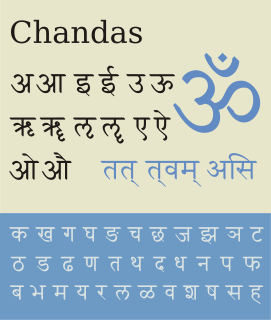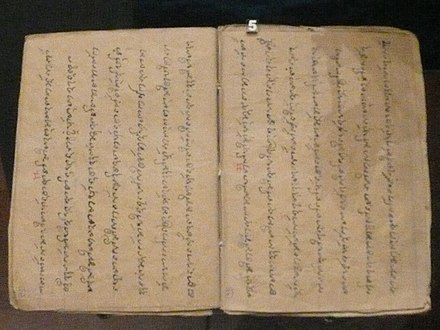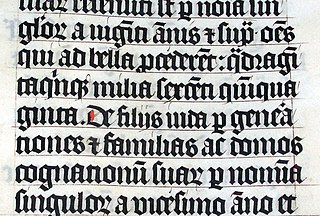
An alphabet is a standard set of letters that represent the phonemes of any spoken language it is used to write. This is in contrast to other types of writing systems, such as syllabaries and logographic systems.

An abjad is a type of writing system where each symbol or glyph stands for a consonant, leaving the reader to supply the appropriate vowel. So-called impure abjads do represent vowels, either with optional diacritics, a limited number of distinct vowel glyphs, or both. The name abjad is based on the old Arabic alphabet's first four letters—a, b, j, d—to replace the common terms "consonantary" or "consonantal alphabet" to refer to the family of scripts called West Semitic.

Devanagari, also called Nagari, is a left-to-right abugida (alphasyllabary), based on the ancient Brāhmī script, used in the Indian subcontinent. It was developed in ancient India from the 1st to the 4th century CE, and was in regular use by the 7th century CE. The Devanagari script, composed of 47 primary characters including 14 vowels and 33 consonants, is one of the most adopted writing systems in the world, being used for over 120 languages. The ancient Nagari script for Sanskrit had two additional consonantal characters.

Gurmukhī is a Sikh script modified, standardized and used by the second Sikh Guru, Guru Angad (1504–1552). Gurmukhi is used in the state of Punjab as the official script of the Punjabi language, a language that is also written in Perso-Arabic Shahmukhi script.

The Sinhalese script is a writing system used by the Sinhalese people and most Sri Lankans in Sri Lanka and elsewhere to write the Sinhalese language, as well as the liturgical languages Pali and Sanskrit. The Sinhalese Akṣara Mālāva, one of the Brahmic scripts, is a descendant of the ancient Indian Brahmi script and closely related to the South Indian Grantha script and Kadamba alphabet.
The Kannada script is an abugida of the Brahmic family, used primarily to write the Kannada language, one of the Dravidian languages of South India especially in the state of Karnataka, Kannada script is widely used for writing Sanskrit texts in Karnataka. Several minor languages, such as Tulu, Konkani, Kodava, Sanketi and Beary, also use alphabets based on the Kannada script. The Kannada and Telugu scripts share high mutual intellegibility with each other, and are often considered to be regional variants of single script. Other scripts similar to Kannada script are Sinhala script, and Old Peguan script (used in Burma).
The Brahmic scripts are a family of abugida or alphasyllabary writing systems. They are used throughout the Indian subcontinent, Southeast Asia and parts of East Asia, including Japan in the form of Siddhaṃ. They are descended from the Brahmi script of ancient India, and are used by languages of several language families: Indo-European, Dravidian, Tibeto-Burman, Mongolic, Austroasiatic, Austronesian, and Tai. They were also the source of the dictionary order of Japanese kana.
The Burmese alphabet is an abugida used for writing Burmese. It is ultimately a Brahmic script adapted from either the Kadamba or Pallava alphabet of South India, and more immediately an adaptation of Old Mon or Pyu script. The Burmese alphabet is also used for the liturgical languages of Pali and Sanskrit.

The Tamil script is an abugida script that is used by Tamils and Tamil speakers in India, Sri Lanka, Malaysia, Singapore, Indonesia, and elsewhere to write the Tamil language, as well as to write the liturgical language Sanskrit, using consonants and diacritics not represented in the Tamil alphabet. Certain minority languages such as Saurashtra, Badaga, Irula, and Paniya are also written in the Tamil script.

The Khmer script is an abugida (alphasyllabary) script used to write the Khmer language. It is also used to write Pali in the Buddhist liturgy of Cambodia and Thailand.

The Odia script, also known as the Oriya script) is a Brahmic script used to write the Odia language.

Saurashtra (ꢱꣃꢬꢵꢰ꣄ꢜ꣄ꢬ) is an Indo-Aryan language spoken primarily by the Saurashtrians of South India who migrated from the Lata region of present-day Gujarat over a millennium ago.
The Limbu script is used to write the Limbu language. It is a Brahmic type abugida.

The Tai Le script, or Dehong Dai script, is a script used to write the Tai Nüa language of south-central Yunnan, China. It is written in horizontal lines from left to right, with spaces only between clauses and sentences.
The Jarai language is a Malayo-Polynesian language spoken by the Jarai people of Vietnam and Cambodia. The speakers of Jarai number approximately 262,800 without counting other possible Jarai communities in countries different to Vietnam and Cambodia such as United States of America. They are the largest of the upland ethnic groups of Vietnam's Central Highlands known as Degar or Montagnards and the 25% of the population in the Cambodian province of Ratanakiri.
In orthography, a zero consonant, silent initial, or null-onset letter is a consonant letter that does not correspond to a consonant sound, but is required when a word or syllable starts with a vowel. Some abjads, abugidas, and alphabets have zero consonants, generally because they have an orthographic rule that all syllables must begin with a consonant letter, whereas the language they transcribe allows syllables to start with a vowel. In a few cases, such as Pahawh Hmong below, the lack of a consonant letter represents a specific consonant sound, so the lack of a consonant sound requires a distinct letter to disambiguate.

Hanunuo, also rendered Hanunó'o, is one of the indigenous suyat scripts of the Philippines and is used by the Mangyan peoples of southern Mindoro to write the Hanunó'o language.





















